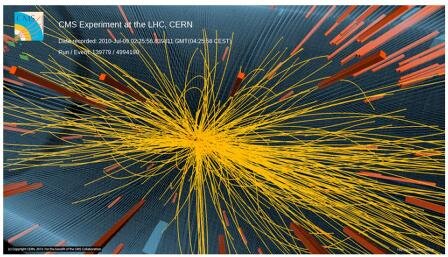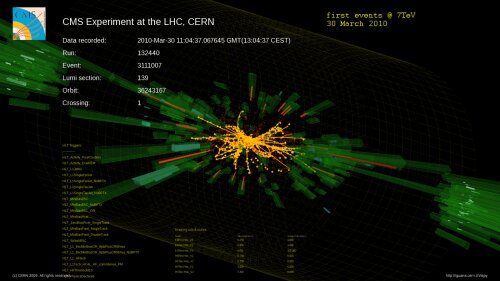Young EPP post-doc Hans Van Haevermaet appointed convener at CMS
Starting from September 1st 2016, FWO postdoc Hans Van Haevermaet of the Elementary Particle Physics Group will lead a team of 70 researchers at CERN. The group is a part of the CMS experiment and focuses their research on the study of strong interactions, one of the four fundamental forces of the Standard Model.
Read more:
UAntwerpen press release (Dutch)
CMS closes major chapter of Higgs measurements, July 2014
The data reveal that the particle discovered at CERN continues to behave just like the Standard Model predicts
Since the discovery of a Higgs boson by the CMS and ATLAS Collaborations in 2012, physicists at the LHC have been making intense efforts to measure this new particle’s properties. The Standard Model Higgs boson is the particle associated with an all-pervading field that is believed to impart mass to fundamental particles via the Brout-Englert-Higgs mechanism. Awaited for decades, the 2012 observation was a historical milestone for the LHC and led to the award of the 2013 Nobel Prize in Physics to Peter Higgs and François Englert. An open question arising from the discovery is whether the new particle is the one of the Standard Model -- or a different one, perhaps just one of many types of Higgs bosons waiting to be found. Since the particle’s discovery, physicists at the LHC have been making intense efforts to answer this question.
This week, at the 37th International Conference on High Energy Physics , a bi-annual major stage for particle physics, which in 2014 is held in Valencia, Spain, the CMS Collaboration is presenting a broad set of results from new studies of the Higgs boson. The new results are based on the full Run 1 data from pp collisions at centre-of-mass energies of 7 and 8 TeV. The analysis includes the final calibration and alignment constants and contains about 25 fb-1 of data.
CERN 06 july 2014
Dr. Mohamed Attia wins the State Incentive Award in Science, June 2014
Dr. Mohammed Attia, a former Ph.D. Student of the UAntwerp Particle Physics Group and a lecturer at Fayoum University in Egypt, was awarded the State Incentive Award in Physical Science for the year 2013, according to the Ministry of Scientific Research of Egypt. He got this prestigious award after submitting five research papers, one of which is published in Science Magazine, one of the world's top scientific journals.
The Particle Physics Group would like to congratulate Dr. Attia for winning this award.
The Particle Physics Group congratulates Prof. Englert with the Nobel Prize, 8 October 2013
Doorbraak in de zoektocht naar het Brout-Englert-Higgs deeltje, juni 2012
Op 4 juli zullen de CMS en ATLAS experimenten van CERN nieuwe resultaten bekendmaken i.v.m. de zoektocht naar het Brout-Englert-Higgs boson. Dit gebeurt via een seminarie in CERN dat ook wereldwijd via webcast zal te volgen zijn.
Zoals vermeld in ons vorige nieuwsbericht ivm de zoektocht naar het Higgs boson, waren de resultaten gebaseerd op de gegevens die verzameld werden in 2011 statistisch niet beduidend genoeg. De vraag was of meer gegevens het waargenomen exces zouden versterken of juist uitwissen.
Ondertussen werd dankzij een goed presterende LHC het gegevensstaal meer dan verdubbeld en hebben we dus, naar aanleiding van de Internationale Conferentie voor Hoge Energie Fysica (ICHEP) die dit jaar in Melbourne wordt georganiseerd, een update van de zoektocht naar het Higgs deeltje voorbereid.
Juni 2012
Nieuwe resultaten i.v.m. de zoektocht naar het Higgs-boson, dec 2011
Vandaag (13 december 2011) hebben we de resultaten bekend gemaakt van onze zoektocht naar het Higgs-deeltje van de laatste 2 jaar met de deeltjesversneller in CERN. Het Higgs-deeltje is het sluitstuk van de theorie voor elementaire deeltjes en is nodig om te verklaren waarom deeltjes massa hebben en om de theorie intern consistent te maken.
Als het Higgs-deeltjes bestaat, zouden we het moeten kunnen produceren met de Large Hadron Collider in CERN. Deze deeltjesversneller laat protonen op elkaar botsen bij een erg hoge energie of snelheid. De kans dat er bij de botsing tussen protonen een Higgs-deeltje ontstaat is echter erg klein en vandaar dat we vele miljarden botsingen moeten onderzoeken om het Higgs-deeltje te vinden.
Het Standaardmodel van de deeltjesfysica voorspelt vele eigenschappen van het Higgs-deeltje, maar zijn massa kennen we niet. Vandaag hebben we al een heel breed bereik in massa's uitgesloten - we weten dus dat als het Higgs boson bestaat, het al zeker niet die massa heeft - maar er blijft nog een klein gebied over waar we niet zeker zijn of we er nu een Higgs-deeltje zien of niet. In het gebied dat overblijft, vinden we een aantal Higgs-kandidaten, maar deze zouden evengoed te wijten kunnen zijn aan achtergrondbotsingen die een Higgs-signatuur nabootsen.
Meer informatie is beschikbaar via Scilogs en op de website van het CMS experiment.
December 2011
Een oersoep van elementaire deeltjes geproduceerd in de LHC, sept 2010

Op dinsdag 21 september maakte CERN, het Europees laboratorium voor elementaire deeltjes fysica in Genève een opzienbarend resultaat bekend aan de pers: een onverwachte observatie van een hete en dichte materietoestand vergelijkbaar met condities vlak na de big bang …
De observatie van zogenaamde gecorreleerde deeltjesproductie bij de allerhoogste energie dichtheden die men in de LHC bekomt door het in botsing brengen van bundels protonen wijst op een nieuw fysisch fenomeen. Elementaire deeltjesfysici debatteren druk over de implicaties van dit resultaat.
Het volledige persbericht is terug te vinden online: http://cms.web.cern.ch/cms/News/2010/QCD-10-002/TwoParticleCorrelationCMSStatementFinal_en.pdf
Gelijkaardige observaties gebeurden in het verleden bij het in botsing brengen van zeer zware kernen bij de Relativistic Heavy Ion Collider in Brookhaven waar een plasma van elementaire deeltjes wordt gevormd, een toestand die zeer dicht aanleunt bij de vroegste stadia van ons heelal na de oerknal.
Deeltjesfysici hadden tot voor kort nooit verwacht dat vergelijkbare fenomenen konden optreden in proton-proton botsingen waar de verwachtte energiedichtheid veel lager is.
Onderzoekers van de Universiteit Antwerpen analyseerden als eersten de gegevens, samen met onderzoekers verbonden aan het Massachussets Institute of Technology in de Verenigde Staten en kwamen tot dezelfde conclusies.
De Antwerpse groep presenteert woensdag 22 september om 19.40 uur als eerste de resultaten buiten CERN, op het International Symposium for Multiparticle Dynamics dat toevallig ook doorgaat op de stadscampus van hun universiteit.
Op nationaal vlak bestaat er een geconcentreerde inspanning met onderzoeksteams van de Universiteit Antwerpen, de Vrije Universiteit Brussel, de Universiteit Gent, de Université Libre de Bruxells,
De Université Catholique de Louvain en de Université de Mons Hainaut. Allen droegen bij tot de constructie van een essentieel element van het CMS experiment bij de LHC, een silicium sporenkamer bestaande uit 10 miljoen elektronische sensoren. Belgische onderzoekers zijn dan ook permanent aanwezig op CERN en staan in voor de operatie en monitoring van dit delicate instrument.
De Large Hadron Collider werd, na een vertraagde start in november 2008, in maart 2009 voor het eerst in gebruik gesteld en levert sindsdien een vloedstroom aan nieuwe gegevens. De versneller en haar vier experimenten: CMS, ATLAS, ALICE en LHCb vormen samen het grootste experiment dat ooit door de mensheid werd opgezet. Het is dan ook een globale onderneming waar in totaal meer dan 9000 onderzoekers aan deelnemen.
September 2010
XL International Symposium on Multiparticle Dynamics, Oct 2010
The Particle physics group organises the 40 (XL) edition of the International Symposium on Multiparticle Dynamics, from September 21st until September 25th. This Symposium will be held in Antwerp (Belgium), on the grounds of the University's 16 century city campus. For more information and to register, click on the logo.
June 2010
Prof. Albert De Roeck receives an honorary doctorate, June 2010
Prof. Albert De Roeck, a distinguished member of the Particle Physics Group and a permanent research physicist at the European particle research centre (CERN), received an honorary doctorate from the University of Helsinki. This was presented to him at a special conferment ceremony on 27‐29 May 2010. De Roeck is among the foremost experimental particle physicists and holds a key position at CERN, analysing the physics produced by the Large Hadron Collider. He is a member of the steering group of the CMS experiment, and was among the founders of the FP420 project, which aims to create a new type of experiment system to research elementary matter in extreme conditions.
The Particle Physics Group likes to congratulate Albert with his title of honorary doctor.
June 2010
LHC research programme gets underway, March 2010
CERN Press release March, 30th 2010
Geneva, 30 March 2010. Beams collided at 7 TeV in the LHC at 13:06 CEST, marking the start of the LHC research programme. Particle physicists around the world are looking forward to a potentially rich harvest of new physics as the LHC begins its first long run at an energy three and a half times higher than previously achieved at a particle accelerator.
“It’s a great day to be a particle physicist,” said CERN1 Director General Rolf Heuer. “A lot of people have waited a long time for this moment, but their patience and dedication is starting to pay dividends.”
“We’ve all been impressed with the way the LHC has performed so far,” said Guido Tonelli, spokesperson of the CMS experiment, “and it’s particularly gratifying to see how well our particle detectors are working while our physics teams worldwide are already analysing data. We’ll address soon some of the major puzzles of modern physics like the origin of mass, the grand unification of forces and the presence of abundant dark matter in the universe. I expect very exciting times in front of us.”
Read more...

March 2010
Ir. Wim Beaumont receives "Achievement Award for CMS Construction", March 2010
On March 15th, 2010 the CMS Collaboration Board presented an "Achievement Award for CMS Construction" to members of the CMS Collaboration who made an outstanding personal contribution to the successful construction of CMS. Our colleague Ir. Wim Beaumont received such an award with following citations of the Board: "For outstanding contribution to the construction and testing of the CMS Tracker" and "For outstanding contribution to the CASTOR electronics". The Particle Physics group congratulates Wim for this recognition of his great dedication to the CMS exepriment.
March 2010
Antwerp group contribution to the commisioning of the pixel tracking detector and first physics paper published, March 2010
The paper titled "Commissioning and Performance of the CMS Pixel Tracker with Cosmic Ray Muons" has been published by the Journal Of Instrumentation.
Even before the CMS detector recorded proton-proton collision events initiated by the Large Hadron Collider, it recorded millions of cosmic ray muons traversing the detector. This 'rain' of particles is caused by collisions of mainly protons from outer space with air molecules in our atmosphere. The Antwerp group used these signals to calibrate the response of the silicon track detectors sensors (roughly 70 millions of them) and to determine the efficiency to detect the energy deposited by a traversing elementary particle. The paper can be read online here:
http://iopscience.iop.org/1748-0221/5/03/T03007/pdf/1748-0221_5_03_T03007.pdf
As soon as the CMS detector collected real collision data in november 2009, the previous results were confirmed and directly applied to obtain the spatial distribution of charged particles produced in proton-proton collisions. Several members of our team were present at CERN to analyze the data within ours after the collisions were recorded and processed. The density of charged particles was measured at two centre of mass energies: 0.9 TeV and 2.36 TeV. The 2.36 TeV data brought us into uncharted terrain and broke the highest energy barrier ever reached by an accelerator. The first results indicated that the average number of charged particles produced perpendicular to the collision axis of the protons rises faster with energy than recent models predict. The details of the findings can be consulted in the paper titled: "Transverse momentum and pseudorapidity distributions of charged hadrons in pp collisions at sqrt(s)=0.9 and 2.36 TeV", published in the Journal of High energy Physics:
http://www.springerlink.com/content/t35h6211438476k0/fulltext.pdf
Since March 2010 the center of mass energy has been increased to 7 TeV, half of the design energy of the LHC machine. Updates of the previous measurements are being carried out, which will hopefully confirm our earlier findings ...
March 2010

